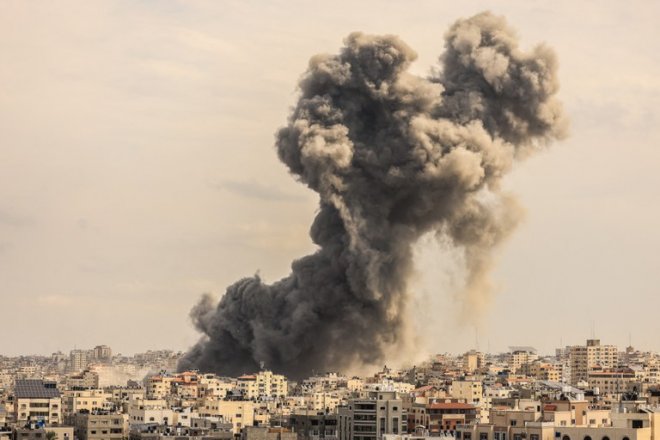China's military carries out year’s first live-fire drill around Taiwan
The Chinese People’s Liberation Army launched its first joint combat drills in 2023 around Taiwan, a move Taiwan’s defense ministry called “irrational and provocative.”The PLA Eastern Theater Command said it “organized the joint combat-readiness security patrol and real-combat exercise involving troops of multiple services and arms in the waters and airspace around the Taiwan Island” on Sunday, the second such drills in less than a month.
The previous “joint combat-readiness security patrol and joint firepower striking exercise” was conducted by the same Command on Christmas Day.
This time, the drills “focused on land strikes, sea assaults and other subjects” in order to “resolutely counter the collusive and provocative acts of the external forces and the ‘Taiwan independence’ separatist forces,” the army said.
On Thursday the U.S. Navy’s Arleigh Burke-class guided-missile destroyer USS Chung-Hoon sailed through the waters between Taiwan and the Chinese mainland, angering Beijing.
China considers Taiwan a breakaway province that will be reunited with the mainland, by force if needed, and strongly protests against the “involvement in the Taiwan issue by external forces.”
The previous drills, on Dec. 25, came two days after U.S. President Joe Biden signed into law a bill allowing up to U.S.$2 billion in loans to help Taiwan boost military capabilities against threats from China.
Analysts say the latest military exercises may not necessarily target Taiwan but “external forces” such as the United States and Japan.
Jie Zhong, a scholar at Taiwan’s Institute for National Defense and Security Research, told RFA Mandarin he believed “the main purpose of the drills is to maintain tension in the Taiwan Strait through long-term high-intensity military activities around Taiwan, and to remind Washington that the U.S. must respect and attach importance to Beijing"s position.”
Another analyst from the same institute, Su Tsu-yun, said the drills were also to express “dissatisfaction with Japan” which has adopted the national security strategy that named China an “unprecedented strategic challenge” and is to strengthen defense in the areas near Taiwan.
 The Eastern Theatre Command of China’s PLA conducts a long-range live-fire drill into the Taiwan Strait, from an undisclosed location, Aug. 4, 2022. Credit: PLA Eastern Theater Command Handout via Reuters
The Eastern Theatre Command of China’s PLA conducts a long-range live-fire drill into the Taiwan Strait, from an undisclosed location, Aug. 4, 2022. Credit: PLA Eastern Theater Command Handout via ReutersDaily drills?
In a statement released Monday, Taiwan’s Ministry of National Defense said the island’s military deployed aircraft, ships and shore-mounted missile systems to “closely monitor and respond” to the Chinese military exercise.
It said China’s “irrational and provocative actions based on groundless accusations have seriously damaged the peace and stability of the Taiwan Strait and the region” and vowed to “firmly defend its sovereignty and national security.”
Over 24 hours from Sunday morning, the PLA sent 57 aircraft and four naval vessels into areas around the island, the ministry said, noting that 28 Chinese planes had crossed the median line – the de facto boundary between Taiwan and China’s mainland.
An AFP database based on daily updates released by Taiwan’s defense ministry shows China sent 1,727 planes into the island’s air defense identification zone (ADIZ) in 2022, nearly double the figure in 2021.
An ADIZ is an area where foreign aircraft are tracked and identified before they reach a country"s airspace.
The highest number of incursions in a month – 440 – was recorded in August, when U.S. House Speaker Nancy Pelosi made a historical visit to Taiwan.
The same month, China held weeklong live fire drills around the island. “Chinese military exercises near Taiwan are becoming a normal phenomenon, raising the specter of a possible military conflict or accident between the two sides,” Sonny Lo, a veteran political commentator in Hong Kong, told RFA in an interview.
The hawkish Chinese newspaper, Global Times, quoted an anonymous Beijing-based military expert as saying that “the PLA"s large-scale exercises around the island of Taiwan [have] become routine, and they take place not only when the PLA announces them, but on a daily basis.”
The U.S. Department of Defense in its 2022 China Military Power Report (CMPR), said the PLA “continues to build and exercise capabilities that would likely contribute to a full-scale invasion,” of Taiwan.
It laid out four possible military courses of action against Taiwan that the PLA may take in the future, ranging from an air and maritime blockade to a full-scale amphibious invasion, but did not give a timeline.
Eva Hsieh in Taipei contributed to this report.
[圖擷取自網路,如有疑問請私訊]
|
本篇 |
不想錯過? 請追蹤FB專頁! |
| 喜歡這篇嗎?快分享吧! |
相關文章
AsianNewsCast























